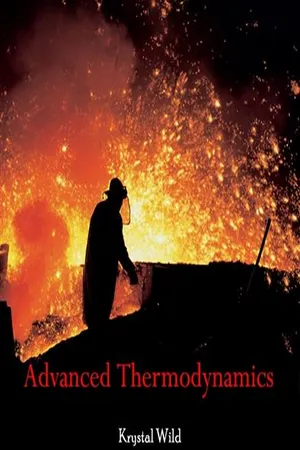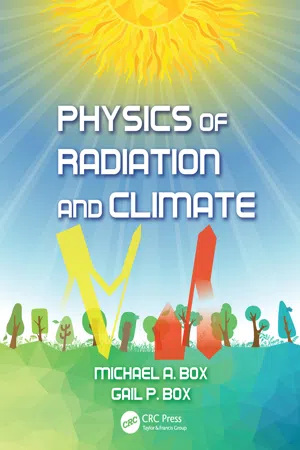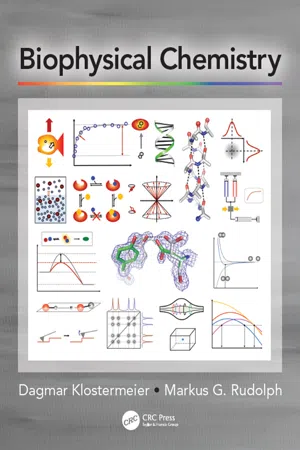Technology & Engineering
Adiabatic Process
An adiabatic process is a thermodynamic process in which there is no heat transfer into or out of the system. This means that the change in internal energy of the system is solely due to work done on or by the system. In practical terms, adiabatic processes are often achieved by insulating the system to minimize heat exchange with the surroundings.
Written by Perlego with AI-assistance
Related key terms
1 of 5
7 Key excerpts on "Adiabatic Process"
- S. Bobby Rauf(Author)
- 2021(Publication Date)
- River Publishers(Publisher)
Chapter 8 Thermodyna mic Processes INTRODUCTION This chapter explores some of the mainstream thermodynamic processes, heat engines and heat engine cycles. Fundamentals of ther-modynamic processes, heat engines, heat engine cycles and associated systems are explained and illustrated through process fow diagrams, graphs, tables and pictures. Practical signifcance, application, analyti-cal methods and computational techniques associated with heat engine cycles and thermodynamic processes are demonstrated through case study, examples and self-assessment problems. THERMODYNAMIC PROCESSES Thermodynamic processes are processes that entail heat, internal energy, enthalpy, entropy, work, pressure, temperature and volume. In this section, we will explore the following thermodynamic processes and illustrate these processes with practical examples: 1. Adiabatic Process 2. Isenthalpic Process 3. Isochoric Process 4. Isothermal Process 5. Isobaric Process 6. Isentropic Process Adiabatic Process Adiabatic Process is a thermodynamic process in which no heat either enters or leaves the thermodynamic system boundary. An adia-batic process can also be explained through the following mathemati-cal statements or equations: 149 150 Thermodynamics Made Simple for Energy Engineers ΔU = -W Eq. 8-1 ΔQ = 0 Eq. 8-2 Equations 8-1 and 8-2 essentially state that in an adiabatic pro-cess, wherein no heat is gained or lost, any work performed on the sys-tem or by the system is transformed into a net change in the internal energy of the system. As specifcally stated above, Eq. 8-1 represents a scenario where negative work is involved. In other words, work is being performed by the surroundings onto the system. And, since no heat is transferred to or from the environment in an Adiabatic Process, the work performed by the surroundings onto the system, in this case, is converted into an equivalent amount of increase in the internal ener-gy of the system.- No longer available |Learn more
- (Author)
- 2014(Publication Date)
- Library Press(Publisher)
Another example is the adiabatic flame temperature, which is the temperature that would be achieved by a flame in the absence of heat loss to the surroundings. An Adiabatic Process that is reversible is also called an isentropic process. Additionally, an Adiabatic Process that is irreversible ________________________ WORLD TECHNOLOGIES ________________________ and extracts no work is in an isenthalpic process, such as viscous drag, progressing towards a nonnegative change in entropy. One opposite extreme—allowing heat transfer with the surroundings, causing the temperature to remain constant—is known as an isothermal process. Since temperature is thermodynamically conjugate to entropy, the isothermal process is conjugate to the Adiabatic Process for reversible transformations. A transformation of a thermodynamic system can be considered adiabatic when it is quick enough that no significant heat is transferred between the system and the outside. At the opposite extreme, a transformation of a thermodynamic system can be considered isothermal if it is slow enough so that the system's temperature remains constant by heat exchange with the outside. Adiabatic heating and cooling Adiabatic changes in temperature occur due to changes in pressure of a gas while not adding or subtracting any heat. In contrast, free expansion is an isothermal process for an ideal gas. Adiabatic heating occurs when the pressure of a gas is increased from work done on it by its surroundings, i.e. a piston. Diesel engines rely on adiabatic heating during their compression stroke to elevate the temperature sufficiently to ignite the fuel. Adiabatic heating also occurs in the Earth's atmosphere when an air mass descends, for example, in a katabatic wind or Foehn wind flowing downhill. Adiabatic cooling occurs when the pressure of a substance is decreased as it does work on its surroundings. - eBook - PDF
- Michael A. Box, Gail P. Box(Authors)
- 2015(Publication Date)
- CRC Press(Publisher)
2.3.3 Adiabatic ProcessES Many important thermodynamic processes take place under well-defined, restricted circumstances. We may define the following: ∞ An isobaric process is one taking place at constant pressure. ∞ An isothermal process is one taking place at con-stant temperature. ∞ An Adiabatic Process is one taking place in such a way that there is no exchange of heat between the system and its environment, and no phase changes are occurring. 32 Physics of Radiation and Climate Consider the adiabatic expansion of a gas. The First Law of Thermodynamics becomes du dw = -. Since the work done is positive, u must decrease, and so must T. We now use Equation 2.40 – another form of the First Law – and also the ideal gas equation, to obtain dq T c dT T dp T c dT T R dp p p p º = -= -0 a We may now integrate this equation from some initial state, defined by ( p 0 , T 0 ), to a final state defined by ( p, T ), obtaining ln ln T R c p T T p p p 0 0 = And hence, T T p p 0 0 = æ è ç ö ø ÷ k (2.45) where κ = R / c p = 0.286. Equation 2.45 is known as Poisson’s equation. We may derive two other versions of this result if we use the ideal gas equation: T T 0 0 1 = æ è ç ö ø ÷ -r r g (2.46) and p p 0 0 = æ è ç ö ø ÷ r r g (2.47) These are clearly of limited use in the atmosphere as we usually seek to remove density from our equations at the first opportunity . 2.3.3.1 POTENTIAL TEMPERATURE Poisson’s equation is the basis of the important concept of potential temperature. The potential temperature of a parcel of (dry or unsaturated) air, θ , is the temperature that air would have if it was brought adiabatically from its current temperature, T , and pressure, p , to a reference pressure level of 1000 hPa. Hence, q k = æ è ç ö ø ÷ T p 1000 (2.48) By this (physical) definition, we see that the potential temperature of an air parcel is conserved during an Adiabatic Process. - eBook - PDF
- Hurd C. Willett, Frederick Sanders(Authors)
- 2013(Publication Date)
- Academic Press(Publisher)
CHAPTER II Adiabatic Processes and the Vertical Stability of the Atmosphere I. INTRODUCTORY REMARKS The composition and vertical extent of the atmosphere have been discussed in Chapter I. This discussion has described and defined the medium in which the weather processes occur. But the character of these weather processes, and the conditions under which they may occur, depend upon the physical properties of the constant mixture of gases which constitutes dry air, combined with the variable element water vapor. This chapter is concerned with the physical properties of the atmosphere and their thermodynamic consequences. It is a well-known fact of observation that when a gas is compressed it is heated, when it is expanded it is cooled. This heating or cooling occurs without any exchange of heat between the compressed or expanded volume of gas and its environment. In fact, in the complete absence of such exchange, a definite amount of compression or expan-sion of any particular gas produces a definite amount of heating or cooling which is always the same at the same initial temperature. Such definite changes of state which occur within a volume of gas which is thermally insulated from its environment are referred to as adiabatic changes. The rate of change of pressure with elevation in the free atmosphere was derived in Chapter I. It follows that any body of air which rises or sinks in the atmosphere is subjected to a corresponding expansion or compression. If the change takes place adiabatically, then a definite change of pressure which corresponds to a definite change of elevation produces a definite change of temperature. In general, large-scale ver-tical displacements in the atmosphere take place with so little heat transfer that they may be treated as adiabatic changes. The capacity of air to hold water vapor decreases rapidly with temperature. Precipitation is caused only by the cooling of moist air, which reduces its capacity for water vapor. - No longer available |Learn more
- Dagmar Klostermeier, Markus G. Rudolph(Authors)
- 2018(Publication Date)
- CRC Press(Publisher)
FIGURE 2.13: Comparison of isothermal and Adiabatic Processes . A: For isothermal processes, the product p V is constant, giving rise to a set of isotherms as described by the Boyle-Mariotte law (blue to red for increasing temperatures T ) . During Adiabatic Processes, no heat is exchanged . Therefore, adiabatic expansion leads to a decrease in temperature, and an adiabatic compression leads to an increase in temperature . This results in a crossing of the isotherms and gives rise to a steeper p – V curve, the adiabate (black dotted line) . For Adiabatic Processes, the product pV γ is constant . B: Direct comparison of isotherm (black) and adiabate (red) . 2 .2 The Internal Energy U and the First Law of Thermodynamics 21 The simplest form of a thermodynamic cycle is a coupling of two opposite changes, back and forth, such as the expansion of an ideal gas, followed by the compression to its original state. We first look at an irreversible expansion of an ideal gas at p 1 , V 1 to p 2 , V 2 , followed by an irreversible compression back to the starting state with p 1 , V 1 . The volume change ∆ V is V 2 − V 1 for the expansion and V 1 − V 2 for the compression, and thus equal in size, but opposite in sign. The work w tot over the complete process is then simply the sum of the work involved in the two steps: w w w p V p V tot exp comp = + = − + 2 1 ∆ ∆ eq. 2.37 As p 1 > p 2 , more work has to be performed on the system during compression at p 1 compared to the work the system has performed on its surroundings upon expansion at p 2 . As a consequence, we obtain w tot > 0 eq. 2.38 If we now perform the sequence of expansion and compression to the initial state under reversible conditions, the pressure will be equal to the gas pressure according to the ideal gas law throughout the process. Under reversible conditions, we therefore obtain for w tot : w w w nRT V V nRT V V tot exp comp ln ln = + = − − 2 1 1 2 eq. - eBook - PDF
- Murry L. Salby(Author)
- 2012(Publication Date)
- Cambridge University Press(Publisher)
If no heat is exchanged between a system and its environment, the control sur-face is said to be adiabatic . Otherwise, it is diabatic . Because, for many applications, heat transfer is slow compared with other processes that influence a parcel, adiabatic behavior is a good approximation. Obviously, heat transfer must be central to pro-cesses that operate on long time scales, as it is ultimately responsible for driving the atmosphere into motion. For this reason, diabatic effects prove to be important for the long-term maintenance of the general circulation, even though they can be ignored for behavior that operates on shorter time scales. 2.1.4 State variables and thermodynamic processes In general, describing the thermodynamic state of a system requires specifying all of its properties. However, that requirement can be relaxed for gases and other substances at normal temperatures and pressures. A pure substance is one whose thermodynamic state is uniquely determined by any two intensive properties. For such a system, inten-sive properties are called state variables . From any two state variables z 1 and z 2 , a third z 3 may be determined through an equation of state of the form f ( z 1 , z 2 , z 3 ) = 0 , or, equivalently, z 3 = g ( z 1 , z 2 ). In this sense, a pure substance has two thermodynamic degrees of freedom . Any two state variables uniquely specify its thermodynamic state. An ideal gas is a pure sub-stance. It has as its equation of state the ideal gas law (1.1). Because no more than two intensive properties are independent, the state of a pure substance may be specified in the plane of any two of its state variables ( z 1 , z 2 ) . The latter represents the state space of the system. It defines the collection of all possible thermodynamic states. For instance, the state space of an ideal gas may be represented by the v − T plane. Any third state variable is then described by a surface, as a function of the two independent state variables. - eBook - PDF
- J Kestin(Author)
- 2012(Publication Date)
- Academic Press(Publisher)
Fig. 2 a. Reversible adiabatic (isentrope). A, and isothermal, I, for a perfect gas in the Γ, V-plane. In order to obtain a clear idea of the reversible nature of a process we imagine the gas to be confined in a cylindrical vessel of cross-sectional area A . The vessel is, in turn, enclosed by walls which prevent any exchange of heat, and the gas is contained at the top by a weightless piston. The piston is maintained in equilibrium by a weight P = p A which balances the gas pressure. We imagine P to be subdivided into many small weights δΡ which will be removed one by one. This causes the piston to rise each time, its pressure p decreasing. Each weight δΡ is placed outside the vessel at the same level at which it has been removed so that no work is gained or lost in the process. The gas pressure will fall from its initial value p (e. g. 2 kp/cm 2 ) 22 THERMODYNAMICS. GENERAL CONSIDERATIONS 5. to a final value p x (say 1 kp/cm 2 ), and the volume will increase from an initial value V (e. g. 1 liter) to a final value V x (in our example 2 1/y liter). The center of gravity of each bP has been raised compared with its original level. This work against the forces of gravity stems from the work performed by the gas on the piston. It has not been lost, being found stored in the raised dP's. If we now replace these weights one by one on the piston, the gas will be re-compressed and heated and will revert to its initial state. The process is reversible on condition that it has been carried out in infinitely small steps and sufficiently slowly, 1 i. e. with a sufficiently fine subdivision of P into elements of δΡ each. B. THE IRREVERSIBLE Adiabatic Process If the piston (together with the weight P) is raised suddenly the gas will first flow into a vacuum performing no external work. The resulting turbulent motion gradually subsides, the gas coming to rest.
Index pages curate the most relevant extracts from our library of academic textbooks. They’ve been created using an in-house natural language model (NLM), each adding context and meaning to key research topics.






